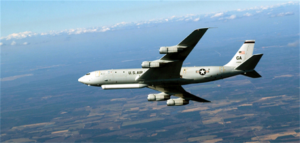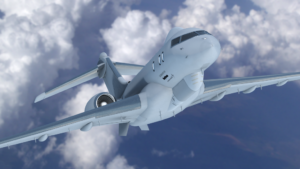No More Waiting: Forge Straight Ahead On JSTARS
Posted on
Canada-based Bombardier joined the Lockheed-Raytheon team to build a replacement for the aging JSTARS (Joint Surveillance Targeting and Attack Radar System) aircraft during the Paris Air Show. Northrop Grumman, announced the week before that it would team with General Dynamics, Gulfstream, and L-3. Boeing is going big, with a 737.
The Air Force recently announced the first JSTARS contracts, and the Air Force Chief testified to Congress on the program’s importance. Lockheed won $10.5 million. Northrop Grumman, the incumbent, got $10 million. Boeing received just under $10 million. The JSTARS fleet is due for retirement in 2019 so there’s not a lot time to build a replacement. A former JSTARS operator, now a professor at George Mason University, penned this opinion piece urging the Air Force and the Pentagon to move straight ahead on the program. Read on. The Editor.
The program to recapitalize the Joint Surveillance Target and Attack Radar System (JSTARS) is struggling to retain its priority for funding in the face of higher priority programs. The Office of Secretary of Defense must join the Air Force in fully committing to this crucial program. The Air Force recently announced the first JSTARS contracts, and Air Force Chief of Staff Gen. Mark Welsh testified to Congress on the program’s importance.
Joint combatant commanders won’t lose their need for the current JSTARS to meet their surveillance and manned BMC2 needs; in the interest of both effectiveness and cost savings, the Pentagon should put the JSTARS Recap program back on an accelerated schedule now.
The Air Force decided years ago that a business jet could perform the total JSTARS mission with increased effectiveness and lower costs than keeping the current fleet of refitted Boeing 707s. Endless studies over secondary issues have delayed the decision to start the new program. That must end.
Over time, for a variety of reasons, JSTARS has come to be considered as simply an intelligence platform, leading some to favor doing its mission remotely. But JSTARS’ unique capabilities for real-time targeting and BMC2 require a manned platform. Throughout its existence, JSTARS has simultaneously conducted targeting and BMC2 functions while supporting remote intelligence activities. It is past time to stop arguing whether JSTARS should be operated as a battle management, targeting, or intelligence platform. It performs all three functions now, and history suggests that demand for all of these capabilities will continue in the future.
With a “bizjet” as the air vehicle, the JSTARS Recap program will field a system operating from shorter runways closer to operating areas, flying at higher altitudes, and leveraging commercial logistics centers globally. Embedding advanced, automated mission systems will allow it to operate with a significantly reduced crew. In aggregate, these factors significantly reduce cost of ownership.
Delays in starting the Recap program have forced it to compete with other critical Air Force programs for scarce funds. The delays put the Air Force in a “Catch 22.” Because of these delays, the Air Force must divert funds from recapitalization to update the current JSTARS fleet because the E-8C now needs upgrades to its avionics and mission systems so it can operate globally and network with all players in today’s joint force. This puts an additional burden on the Air Force budget.
Over the years, JSTARS has proven to be the quarterback of the joint force, surveilling the opposition, commanding the overall scheme of maneuver, and executing plays in real time for all players in the combat operation. All combatant commanders put JSTARS high on their priority list of forces. Therefore, every service should champion JSTARS, not just the Air Force as its provider. To maintain the current fleet and recapitalize it with a replacement places a substantial burden on the Air Force budget. Pentagon planners must recognize the demands on the capability provider and the unmet needs of its operational users and ensure that the E-8C and JSTARS Recap program receive the attention and funding they need. Our joint force commanders demand it now, and will demand it even more in the future.
JSTARS has played a major role in every military operation since it was fielded 25 years ago, but its capabilities have been largely misperceived, and its contributions largely unrecognized. Few appreciate just how indispensable this star player is to the joint team. As both a crew member and operational user, I cannot imagine conducting a major joint-force operation without JSTARS operating in all three of its roles — wide area surveillance, matching shooters with targets in real-time, and providing theater-wide battle management, and command and control. A brief review of its contributions over the years shows its value.
In Desert Storm, 1991, JSTARS helped turn the tide in the battle of Khafji, the first ground fight in the war.
In Operation Joint Endeavor, 1995, JSTARS gave commanders a clear picture of ground movements in Bosnia and Herzegovina allowing NATO aircraft to strike targets in support of the indigenous defenders.
In Operation Allied Force, 1999, JSTARS supported air operations over Kosovo including delivery of humanitarian aid.
In Operation Enduring Freedom, 2001, JSTARS directed air strikes against the Taliban in Afghanistan which directly led to their quick defeat by the Northern Alliance.
In Operation Iraqi Freedom, 2003, JSTARS was key to the Army and Marine thrust to capture Baghdad quickly, the counter-Scud campaign in Iraq’s western desert, and the Kurds defending the northern oil fields.
In Odyssey Dawn, 2011, JSTARS once again proved it value by observing the movement of hostile forces on the ground and pairing strike fighters against targets in real-time. Later, JSTARS effectively watched over Libya to enforce the UN arms embargo.
Southern Command relies on JSTARS to spot and help interdict drug-running ships.
Pacific Command constantly uses JSTARS to track North Korean army movements and provide indications of force increases.
Most recently, JSTARS allowed the Army and Marines to find the “rat lines” insurgents built to move people and equipment into Afghanistan clandestinely, and provided analysts with information to predict patterns of life and forensic analysis.
These widely varied scenarios amply demonstrate the triple-threat capabilities of JSTARS for wide area surveillance, real-time targeting, and BMC2, doing all three at the same time in most cases.
Retired Air Force Lt. Gen. Robert Elder, past commandant of the Air War College and former JSTARS crew member, is now a research professor at George Mason University specializing in command and control systems. He advises Northrop Grumman and other defense companies.
Subscribe to our newsletter
Promotions, new products and sales. Directly to your inbox.



